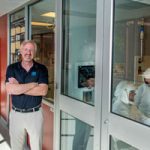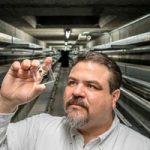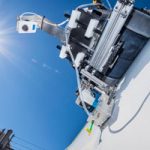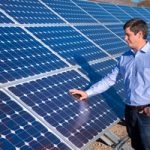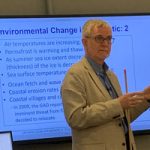Strategic Priority No. 3
Strategic Priority No. 3: Never surprises, always options: Anticipating threats to national security through Intelligence Science
Portable gas detection shrinks to new dimensions
A sensor for detecting toxic gases is now smaller, faster and more reliable, thanks to researchers at Sandia. The sensor’s performance sets it up for integration into a highly sensitive, portable system for detecting chemical weapons. The sensors can also rapidly detect airborne toxins.
Don’t set it and forget it — scan it and fix it with tech that detects wind blade damage
Drones and crawling robots outfitted with special scanning technology could help wind blades stay in service longer, which may help lower the cost of wind energy at a time when blades are getting bigger, pricier and harder to transport, Sandia researchers say.
Rooftop solar panels get boost from Sandia tool
Homeowners and businesses may now have an easier time getting solar panels on rooftops thanks to software developed at Sandia. The new software can run a detailed, second-by-second simulation that shows utility companies how rooftop solar panels at a specific house or business would interact with a local electrical grid throughout the year.
A day in the life of Sandia — 70 years and counting
To mark the 70th anniversary of President Truman’s letter that inspired Sandia to “… exceptional service,” Lab News photographer Randy Montoya spent a full day chronicling the people and work that make the Labs hum from sun up to sundown.
Army Lab geophysicist details shifting Alaska climate
Federal geophysicist Martin O. Jeffries told a Sandia audience last month that understanding rapidly changing Arctic weather conditions is vital to understanding the global climate. Jeffries' talk was titled “Understanding and Predicting the Rapidly Changing Arctic: The Need for Enhanced Collaboration in Research.”
Training to defend
Sandia’s Security Police Officers go through intense weapons training annually to protect members of the workforce from any possible threat, and that training recently took place at Sandia.
Sandia lends expertise to hydrogen center
Sandia is building on longstanding partnerships to help found a new global center focused on safety and best practices for the use of hydrogen in the global energy transition. The American Institute of Chemical Engineers, in partnership with Pacific Northwest National Laboratory, recently launched the Center for Hydrogen Safety.
Future hypersonics could be artificially intelligent
A test launch for a hypersonic weapon — a long-range missile that flies a mile per second and faster — takes weeks of planning, and it's uncertain how useful test systems will be against urgent, mobile or evolving threats. But Sandia's hypersonics developers think artificial intelligence and autonomy could slash these weeks to minutes for deployed systems.
B61-12 team reaches milestones in nuclear deterrence mission
Sandia’s B61-12 nuclear weapons team has accomplished several milestones, including the gravity bomb’s final design review and the first production completion of several components for the life extension program. Sandia and LANL presented the B61-12 design for final review to an independent peer-review panel of 12 military and civilian experts last fall.
